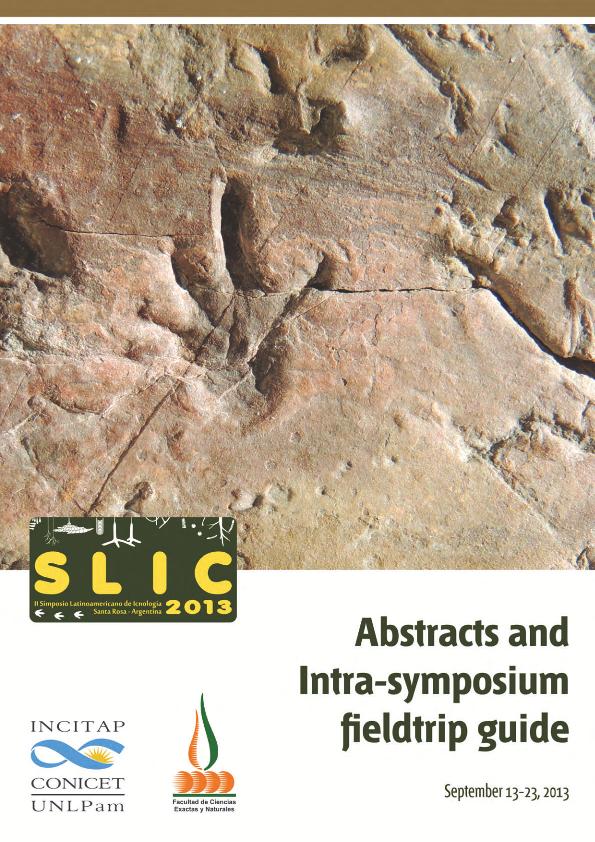Evento
Ichnostatistics applied to sedimentary models and oil basin analysis
Colaboradores:
Bedatou, Emilio ; Sostillo, Renata
; Sostillo, Renata ; Varela, Julio Adrian
; Varela, Julio Adrian
 ; Sostillo, Renata
; Sostillo, Renata ; Varela, Julio Adrian
; Varela, Julio Adrian
Tipo del evento:
Simposio
Nombre del evento:
Second Latin American Symposium on Ichnology
Fecha del evento:
16/09/2013
Institución Organizadora:
Universidad Nacional de La Pampa;
Universidad Nacional de La Pampa. Facultad de Ciencias Exactas y Naturales. Instituto de Ciencias de la Tierra y Ambientales de La Pampa;
Título del Libro:
Abstracts and Intra-Symposium Fieldtrip
Editorial:
Universidad Nacional de La Pampa
Idioma:
Inglés
Clasificación temática:
Resumen
The use of statistical tools has been widely applied in science in general and also particulary in natural sciences. The geology and paleontology have not been the exception. Furthermore, in the beginning of ichnology, statistics have been used primarily in ichnotaxonomy, especially for the identification of ichnoespecies through morphometric measures, which it is not accepted today in the ichnotaxobase concept. In the last decades, new numerical concepts have been introduced, such as the maximum diameter of trace or bioturbation index that have led to interpret environmental aspects such as oxygenation and salinity. Recent sedimentological investigations, carried out in the Paleozoic of the Bolivian Subandean, have provided new advances and applications what is here called "Ichnostatistic" to unlock the paleoenvironmental distribution of trace fossils, ichnofacies and ichnolitological associations. By the other hand, this ichnostatistic analisys try to link their results with geoelectric tools largely used in the oil industry. Surprisingly, in this case the geoelectric logs are reflecting the trace fossil content than the recorded lithology. The aim of this talk is to show the results of one of the most successful research about the Huamampampa Formation and the methodology used to conduct this study, which includes measurement every 5 cm of Numerical Facies (NF), Bioturbation Index (BI), Ichnodiversity Index (IdI), Ichnogenus Size Ordering (ISO), and the geostatistic analysis of their obtained curves. The Huamampampa Formation had been classically interpreted as the product of shallow open-marine sedimentation in a Devonian shelf. However, this ichnological and sedimentological studies conducted on six cores and three outcrops have allowed the recognition of the occurrence of brackish water sedimentation during the deposition of the Huamampampa Formation.Trace fossils identified in cores and outcrops include Arenicolites, Asterosoma, Bergaueria, Chondrites, Cylindrichnus, Diplocraterion, Helminthopsis, Macaronichnus, Neonereites, Palaeophycus, Phycodes, Planolites, Rhizocorallium, Rosselia, Skolithos, Teichichnus, and Zoophycus.These ichnogenera are grouped in the Cruziana, Skolithos and an impoverished ichnofacies. Then, ichnofacies and ichnolithological associations have been used to recognise different subenvironments in a tide-dominated delta (or estuarine)-shallow marine environment. The ichnolithological associations identified are i) Sandy facies with Cruziana ichnofacies (S-Cr), high bioturbation and ichnodiversity (assigned to shallow marine, upper shoreface); ii) Sandy facies with Impoverished ichnofacies (S-Imp), low bioturbation and ichnodiversity, general size reductions of ichnogenera (tide-dominated delta or estuarine, longitudinal bars, brackish water); iii) Sandy facies with Impoverished-Skolithos ichnofacies (S-Imp-Sk), low bioturbation and ichnodiversity, isolated Skolithos (top of longitudinal bars, high-energy pulses); iv) Sandy facies with belts of Arenicolites (S-bAr), horizontal levels of just Arenicolites up to 5 cm thick (high energy pulses crossing different facies, in the delta front or in the shoreface); v) Sand-rich heterolithic facies with Cruziana ichnofacies (Hts-Cr), moderate bioturbation and ichnodiversity (shallow marine, upper to middle shoreface); vi) Sand-rich heterolithic facies with Cylindrichnus and Rosselia (Hts-Cyl-Ros), moderate bioturbation and low ichnodiversity (shallow marine, upper shoreface); vii) Heterolithic facies with Cruziana ichnofacies (Ht-Cr), high bioturbation and ichnodiversity (shallow marine, transition zone between lower shoreface and offshore, open shelf); viii) Heterolithic facies with Impoverished ichnofacies (Ht-Imp), low bioturbation and ichnodiversity, reduced size of trace fossils (tide-dominated delta or estuarine, delta front, brackish water); and ix) Sandy facies with no bioturbation (S-Not Biot), interpreted as fluvial channels.
Palabras clave:
TRACE FOSSILS
,
STATISTICS
,
HUAMAMPAMA FORMATION
,
DEVONIAN
,
OIL BASINS
,
BOLIVIA
Archivos asociados
Licencia
Identificadores
Colecciones
Eventos(CIG)
Eventos de CENTRO DE INVEST.GEOLOGICAS (I)
Eventos de CENTRO DE INVEST.GEOLOGICAS (I)
Citación
Ichnostatistics applied to sedimentary models and oil basin analysis; Second Latin American Symposium on Ichnology; Santa Rosa; Argentina; 2013; 20-20
Compartir



